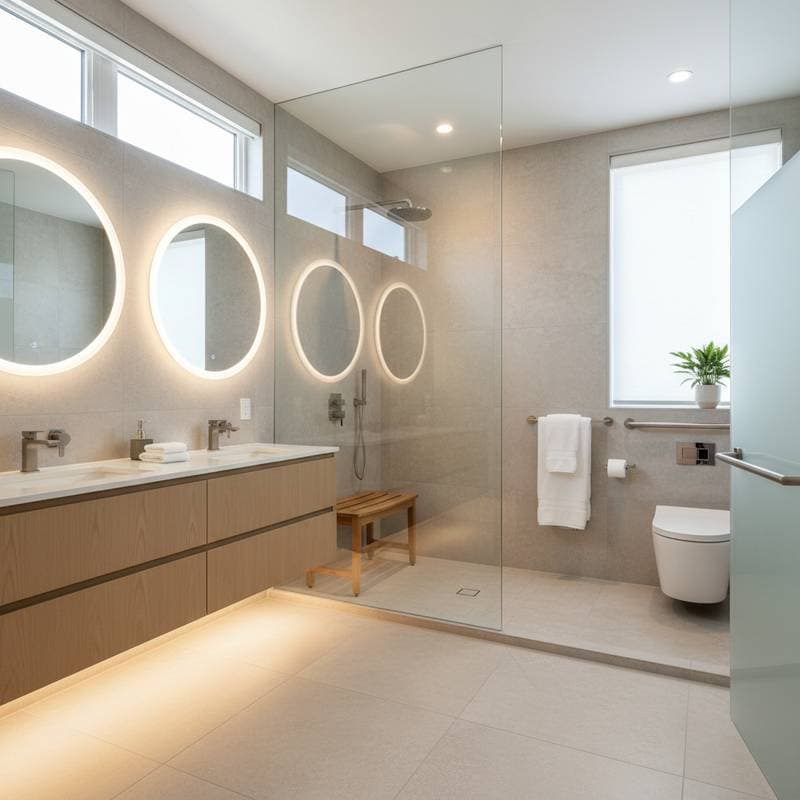Unlock 15% Resale Value Through Aging-in-Place Bathroom Renovations
Aging-in-place bathroom renovations provide immediate comfort and safety while delivering a typical return on investment of 15 percent. These projects typically cost between $12,000 and $24,000, depending on the selected accessibility features and material finishes. The focus remains on enhancing independence and durability without compromising the aesthetic appeal of the space.
Such remodels prioritize practical elements like grab bars, curbless showers, and slip-resistant flooring. These upgrades support daily living needs and appeal to future buyers seeking versatile home designs. Homeowners benefit from a bathroom that adapts to changing mobility requirements over time.
Key Cost Considerations
Costs vary based on project scope, location, and material quality. Understanding these factors helps in setting a realistic budget and avoiding unexpected expenses.
Materials
Select durable, low-maintenance options to balance cost and longevity.
- Grab bars range from $40 to $150 per unit, with prices influenced by material such as stainless steel or brushed nickel finishes.
- Curbless shower bases cost $1,000 to $2,500, including custom sizing for seamless integration with existing floors.
- Slip-resistant tiles are priced at $3 to $8 per square foot, offering textures like mosaic patterns or matte surfaces for enhanced grip.
- Walk-in tubs fall between $3,000 and $8,000, featuring therapeutic jets and quick-drain systems for added functionality.
Labor
Professional labor constitutes 40 to 60 percent of the total budget. Skilled trades handle complex tasks like plumbing rerouting and waterproofing to ensure structural integrity.
Hiring certified installers prevents issues such as uneven slopes that could lead to water pooling. Expect higher rates in urban areas due to demand and regulatory requirements.
Layout Modifications and Accessibility
Adjusting doorways or relocating fixtures adds $1,000 to $3,000 to the project. In confined spaces, additional labor compensates for limited access and precise measurements.
These changes create at least 30 inches of clear doorway width and 60-inch turning radii, essential for wheelchair maneuverability.
Permits and Compliance
Local permits cost $200 to $600 and verify adherence to accessibility codes. Regulations often mandate 30-by-60-inch clear floor space around toilets and lever-style handles on faucets.
Consult building inspectors early to streamline approvals and incorporate any required adjustments.
Additional Expenses
Fixture removal and waste disposal contribute $300 to $800. Coordinate with contractors to recycle materials where possible, reducing environmental impact and fees.
DIY Options Versus Professional Services
Certain tasks suit homeowners with basic skills, allowing cost savings without sacrificing quality. However, complex work demands expert intervention to maintain safety standards.
Suitable DIY Projects
- Secure grab bars by locating wall studs with a stud finder and using corrosion-resistant screws.
- Update faucets and showerheads with low-flow models that install via simple threading onto existing pipes.
- Apply mildew-resistant paint to walls and ceilings, following manufacturer instructions for even coverage.
- Install removable non-slip mats or foldable shower seats for temporary enhancements.
These steps require standard tools like drills and wrenches, typically completable in a weekend.
When to Engage Professionals
Opt for licensed contractors in scenarios involving structural changes.
- Relocating plumbing or electrical components to accommodate new layouts.
- Constructing curbless showers, which demand precise sloping for effective drainage.
- Installing walk-in tubs, requiring reinforced floors to support added weight.
- Applying waterproofing membranes under tiles to prevent moisture damage.
- Widening doorways or reinforcing walls for stability.
Professionals guarantee compliance with codes, such as ensuring grab bars support 250 pounds of force. A minor oversight, like inadequate sealing, could result in mold growth and repairs exceeding $5,000.
Ongoing Maintenance and Warranty Essentials
Regular upkeep preserves the investment and extends the lifespan of renovations. Proactive care minimizes wear and supports warranty validity.
Daily and Periodic Maintenance
- Wipe grout lines weekly using a mild, non-abrasive cleaner to inhibit mold and mildew.
- Inspect caulk around fixtures every six months, resealing any cracks to block water intrusion.
- Renew shower door seals every three to five years to maintain airtight performance.
- Verify grab bar stability annually by applying firm pressure and tightening as needed.
Document these activities in a maintenance journal for reference during inspections.
Warranty Details
Most fixtures carry warranties of three to 10 years, covering defects in materials and workmanship. Waterproofing systems often extend to 10 years or longer when installed by authorized professionals.
Walk-in tubs frequently include lifetime coverage on critical components like door seals and hydrotherapy pumps. Review product documentation at purchase to understand claim processes and exclusions.
Employ gentle cleaning methods, such as vinegar solutions, to avoid voiding protections. Store warranty cards securely for quick access.
Implementing Your Renovation Plan
Begin by assessing your current bathroom layout and identifying priority safety concerns, such as slippery surfaces or low fixtures. Establish a budget that allocates funds across materials, labor, and contingencies.
Solicit detailed quotes from at least three contractors experienced in universal design principles. Request breakdowns of costs for labor, fixtures, and permits, and confirm their familiarity with standards like 18-inch toilet clearances and 34-inch maximum sink heights.
For resale appeal, choose timeless finishes in neutral tones, such as soft grays or whites, paired with contemporary hardware. Avoid overly clinical appearances by incorporating stylish elements like frameless glass enclosures.
Consider a phased approach to manage expenses: Start with flooring and lighting upgrades for instant safety gains, followed by shower modifications in the next phase. This strategy delivers progressive improvements without overwhelming the budget.
Aging-in-place renovations extend beyond mere accessibility; they foster long-term independence through thoughtful, inclusive design. With careful planning, these updates yield a 15 percent return on investment, alongside a bathroom that enhances daily life and market value for years to come.









